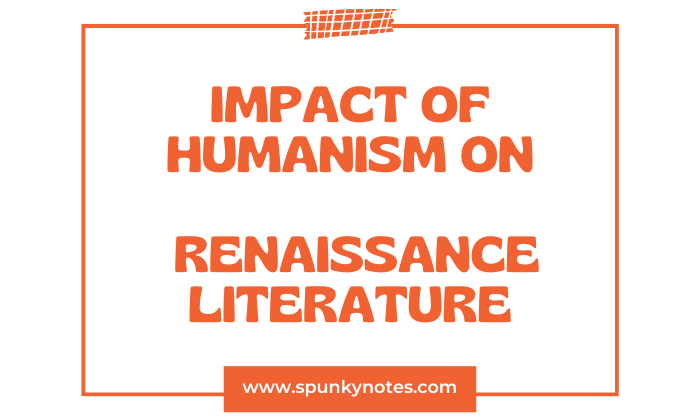
Q. Discuss the impact of humanism on Renaissance literature. How did it change the portrayal of human characters?
Humanism in Literature
Humanism is a significant intellectual movement that originated during the Renaissance period. It revolutionized people’s thoughts about education, art, and the human experience.
Rooted in the study of classical Greek and Roman texts, humanism emphasizes the value of individual human beings. Rather than focusing on religious dogma or feudal traditions.
Humanists advocated for a return to the teachings of ancient philosophers, poets, and scholars. People like Petrarch, often considered the founder of Humanism, advocated for learning in areas like grammar, rhetoric, history, poetry, and moral philosophy to promote wisdom and good behavior.
The effects of humanism extended beyond academia; they reshaped art, politics, and everyday social interactions. This shift in perspective moved the focus from a God-centered worldview to one that highlighted human skills and accomplishments
Impact of Humanism on Renaissance Literature
1- Characters Became More Realistic
The influence of humanism on Renaissance literature led to a remarkable transformation in how characters were depicted. In contrast to the one-dimensional archetypes often seen in medieval stories, Renaissance characters became much more realistic.
Take Shakespeare’s Hamlet as a prime example. Hamlet is not just a prince seeking revenge but a multi-faceted individual wrestling with complex emotions and existential dilemmas. This depth allows audiences to see elements of themselves reflected in him.
Similarly, the women in Renaissance literature started to have more agency and depth. In Shakespeare’s plays like “Othello” and “Romeo and Juliet,” female characters such as Desdemona and Juliet are not mere accessories to male action but have their own desires, fears, and moral quandaries.
Overall, humanism’s emphasis on individual potential and complexity gave writers the creative freedom to explore characters in a more in-depth and psychologically accurate way.
2- Focus on the Individual’s Inner Life
Focusing on an individual’s inner life is one of the defining characteristics of Renaissance literature. In Shakespeare’s “Hamlet,” we see the prince’s internal struggle with grief, duty, and ethical ambiguity through soliloquies that reveal his deepest thoughts.
3- Decline of Divine Centralization
Humanism in Renaissance literature significantly influenced the decline of divine centralization. While medieval literature often portrayed characters as pawns in a cosmic, divine game, Renaissance works focused on individual human agency, moral choice, and personal responsibility.
In Christopher Marlowe’s “Doctor Faustus,” religious and supernatural elements are present. However, the narrative mainly focuses on Faustus’ human flaws and ambitions. He is not just a victim of divine will; he makes conscious choices that lead to his downfall.
In plays like Shakespeare’s “Othello” or “Romeo and Juliet,” the story is not t just about fate or destiny. It also shows how the choices people make can lead to sad endings.
This change lets writers explore people’s thoughts and social issues more deeply. Instead of just talking about fate, they started focusing on how human choices lead to different outcomes.
It was a change that made literature more relatable. This resonates with the audience’s experiences of making choices and facing the repercussions.
4- Exploration of Broader Themes
The Renaissance era explored broader themes in literature, moving beyond the religious and feudal narratives of earlier periods.
Works like Shakespeare’s “Macbeth” tackled themes of ambition and corruption, while Thomas More’s “Utopia” questioned the very foundations of society and governance.
This thematic expansion allowed literature to serve as a platform for intellectual inquiry and cultural critique.
5- Emphasis on Learning and Knowledge
The humanistic emphasis on learning and knowledge is a defining feature of Renaissance literature. During this period, education was not seen merely as a path to vocational skills but as a means to enrich the individual’s mind and soul.
Writers like Erasmus emphasized the importance of a well-rounded education, including the study of literature, philosophy, and the sciences.
In many literary works, such as Thomas More’s “Utopia,” the value of education is a recurring theme, often portrayed as a path to ethical living and enlightened governance.
6- Revival of Classical Ideas
The revival of classical ideas, another hallmark of humanism, profoundly influenced Renaissance literature. The authors drew inspiration from ancient Greek and Roman texts.
For example, John Milton’s “Paradise Lost” blends classical mythology with Biblical narratives, creating a rich, multi-layered epic. The use of classical elements elevates the subject matter, enriches the narrative, and connects Renaissance audiences to a broader humanistic tradition.
7- Embrace of Human Flaws
The embrace of human flaws became a prominent feature in Renaissance literature, representing a break from earlier works that often portrayed characters as paragons of virtue or embodiments of evil.
With a humanist focus on the complexities of the individual, writers started making characters that show all kinds of human experiences.
Shakespeare’s protagonists, for instance, are often a mix of strengths and weaknesses. King Lear’s pride and stubbornness led to his downfall, yet his character also displayed profound love and vulnerability. Othello’s tragic flaw is his jealousy, making a heroic figure tragically human.
This portrayal provided a more realistic reflection of humanity, where imperfections were not merely condemned but explored as integral facets of the human condition.
This shift allowed for a richer, more empathetic connection between the reader and the characters. It presents the idea that imperfection is not only inherent but also relatable.
For example, Othello, in Shakespeare’s tragedy, is both a loving husband and a man consumed by jealousy. This complexity makes him a compelling, relatable figure, and his flaws are treated as an integral part of his humanity rather than moral failings to be judged.
Conclusion
Humanism fundamentally altered how writers approached characters and themes in Renaissance literature. Complex characters like Hamlet and the internal conflicts in “Macbeth” show how humanist ideas changed these stories.
It expanded the literary focus from divine intervention to human choice, from moral black-and-whiteness to complex ethical dilemmas.

